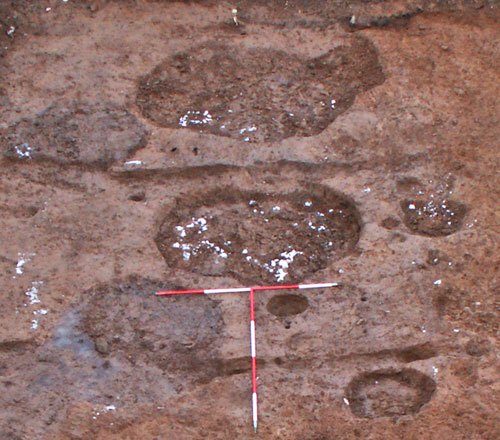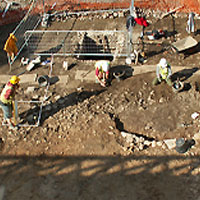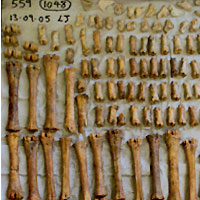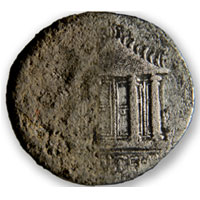The 2005-2006 excavations - part 2
The excavation site lay immediately to the east of Barbican Tower, which forms part of the main south gateway into the castle. A Method Statement and Research Framework was prepared in 2004 which informed an excavation project design which set out the scope of archaeological works, methodology, programme of works and resource levels. A supplement to the project design was prepared in respect of excavation in what is now the kitchen area of the Interpretation Centre which was the subject of a variation to the original permission. Other variations to the granted consents were also needed notably to facilitate the recording of exposed foundations of the wall of the last Roman fort, but also for amendments to drainage and other minor works.
The archaeological excavation works were carried out in five stages:
- A watching brief on the mechanical removal of a bank dating to the 1920s
- Hand excavation of all earlier archaeologically significant deposits
- A watching brief on the mechanical removal of natural deposits
- Hand excavation of all archaeologically significant deposits affected by the construction of the kitchen area
- A watching-brief on services and recording of the foundations of the wall of the last Roman fort
The hand-excavated area measured approximately 35.4m by 15.5m, which was surrounded by a 2m, machine-excavated ring-beam trench on the eastern, western and northern sides. The total excavated area measured approximately 707m2.
Read more about Cardiff Castle Interpretation Centre project design
Key Discoveries
Thirteen distinct phases of activity were found: phases 3-10 relate to the occupation of successive Roman Forts dating to the 1st-4th centuries AD.
Prehistoric
Features of uncertain date perhaps connected with site clearance and containing flints and carbonised food remains. Some prehistoric pottery was also recovered. These are possibly the earliest pieces of evidence yet found for human occupation in the centre of Cardiff.
Roman
Early military activity: building remains (possibly parts of barracks belonging to the first fort (1st century AD), alongside the main north-south road through the fort (which continued in use in later periods). First certain buildings of this date to be found.
Military industrial workings: part of a kiln and features associated with metalworking dating to the second and third centuries AD. Important because of the scale and nature of the metal-working.
Military earthen bank, pre-dating 4th century AD ‘Saxon Shore’ Fort. Previously unknown phase of defences.
Bank and revetment behind the 4th century AD ‘Saxon Shore’ Fort Wall (as surviving) and related construction debris. Previously unattested evidence for the full construction method of these defences.
Extensive collections of artefacts and environmental material that across the 350 years of Roman occupation informs analysis of changing site use, variations in sources of supply, changing economic and social activity. Some exceptional items most notably a complete copper-alloy dodecahedron. Some collections of material are extensive (eg 18,500 sherds of Roman pottery).
Later periods
Remains and material from 11-18th centuries AD were also recovered, these include some significant artefacts.
Menu
Past excavations Previous archaeological investigations in the area have indicated that four Roman forts, all of slightly differing size and shape, were located on the site before Cardiff Castle was built in the medieval period. Learn More
The 2005-2006 excavations With the building of a new interpretation centre at Cardiff Castle an opportunity for a full archaeological investigation of the proposed area was undertaken. The excavations provided us with fascinating new insights into the history of one of Cardiff’s most prominent landmarks. Learn More
Post-excavation and reporting works The post-excavation assessment works were carried in two stages. These resulted in a completed site summary of the excavated remains by phase and included assessments by specialists of the various categories of artefact and environmental remains. Learn More
Artefact conservation A total of 890 small finds and context designations representing 2000+ individual objects were examined and/or treated between November 2018 and May 2019. Learn more
About the project
Cardiff Castle is one of the most significant heritage assets in the Principality. Sited in the centre of the capital of Wales, it is in the care of Cardiff City Council. The Castle has a long history with physical evidence of remains from the Roman, medieval and early post-medieval remains accessible to visitors and the remarkable neo-gothic restoration.
Please click here to find out more about us and our work








